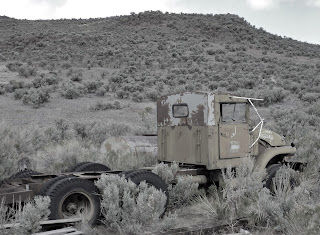On the Cedarville, Burns Winnemucca Tour
Final Installment of the Series
We left Winnemucca intent on avoiding
I-80 as much as possible. The
Nevada copy of DeLorme’s Atlas and Gazetteer tempted us with thin, red lines
linking place names forgotten by the freeway: locales on the edge of being lost
to history.
 |
| (c) WPRR |
We chose something called the Jungo Road, a route that
parallels the tracks of the old Western Pacific fifth subdivision and lead us
through namesake Jungo, Sulphur, Trego Springs and around the edge of the Black
Rock Desert (think Burning Man) to Gerlach.
Departing at 7:15, we assumed the Jungo route off US 95
north of I-80. Straight, flat and
paved across an endless plain of alkali and sage, the road converted to a slurry
of oiled gravel recently watered to minimize dust. Ten minutes out of town, four Coach USA buses approached, returning
from the Haycroft gold mine with a weary night shift. Two or three more were to follow during the course of the 48
miles from town to work. The spray
from the on-coming traffic and the cake-frosting-like texture of the road’s
surface made me glad I was a passenger in the Toyota SUV and not astride the
GSA.
The Western Pacific was the last east-west route to cross
into California. Following the
trail of early 1800s mountain man from Virginia named Jim Beckworth, the WP
makes the lowest elevation passage through the Sierra. Folks suggest this was the easiest
route and the one that should have been completed first. But politics, undoubtedly, were at
play. Something about a Dutch Flat swindle? Leland? Charley?
The WP route seems smooth – easy to construct, as long as
I’m not swingin’ the sledge – with only a turn here and there to go around the
mountain. Now subsumed by the
Union Pacific, Jungo, listed as a siding, proves to be little more than a curve
in the tracks.
A half hour further on, we note to
the north a stand of derelict buildings built low to or into the ground. They deserve our attention. Inspection shows they were constructed
out of used rail ties.
From a rise above this enclave, we look south and see the
activity of the Haycroft’s huge gold mining operation.
Talus debris stretches for four-and-a-half miles, the
various colors of which speak to the rich variety of minerals beneath the
Nevada desert surface.
Toward the end of the extraction zone, we pause for a
picture of Pulpit Rock. Driver
John considers a hike up there and an impromptu sermon, but the closer we get
to the landmark, the higher it rises.
And the area seemed barren of folks in need of our words of salvation –
or anybody else – this day.
The drive the 98 mile length of
Jungo Road proves to be a series of ancient mountains tilted by tectonic
activity divided by flat stretches of one-time lakes filled to their brims with
alluvium from the withering hills.
1860s era pioneers passed this way. A steel marker notes the crossing of
the old Nobles Immigrant Trail.
It appears the route followed a now-dry rill. It was likely easier to parallel the
tiny channel than trundle back and forth across it with ox-driven rolling
stock.
A rise presents one of those Church
of the Open Road vistas where one can see over the small ridge we’re about to
cross and on to the next set of mountains ten or fifteen miles distance – a
scene that asks “What might be next?”
Backing down the hill to angle for the best shot, The GPS
indicates we’ve stopped at a crossroad.
It takes some looking through the sage to realize the electrons are not
speaking in error.
Another steel marker confirms that we are near a place of
some significance.
Amid this dry landscape, a submerged fumarole vents into
water that seemly comes from nowhere reminding us that the change process is
not finished with this landscape.
Here the water bubbles and smells of failed attempts to poach eggs.
Trego Springs: Not
far away, the pool is bathwater temperate.
Some latter-day pioneer installed a pool ladder for those in
need of a soul-cleansing soak. Other
left Coors Light empties. The WP
passes a few yards away. We
consider soaking our feet, cracking a beer and waiting for a freight to pass
by. But in the two-plus hours we’d
monitored the tracks, we’d noted no traffic.
Coursing along the southerly edge of
the Black Rock Desert, we find pavement - Nevada Route 447.
North a couple of miles leads to Gerlach, a point that will
remain on the bucket list for the time being. South leads to I-80 with a quick jaunt past Pyramid Lake, over
the Sierra and home.
We were
pleased to have taken this road-not-taken and enjoyed tidbits of history that
soon – like auld acquaintance – may be forgot. Let’s not let that happen.
Geography, we geographers believe,
is the canvas on which layer upon layer of history is rendered. Whether as far back as the fossil
record or as recent as the latest electronic flash, the spatial relations
outlined in a competent map provide context for nearly every event in pre-human
and human history.
Geography is
what we drive through both on the way to work and on a really interesting
vacation. Pausing along the way,
we discover the stories that inform and fascinate us – challenging us sometimes
to wonder “What if…”
Resources:
Holmes, Norman W., My Western Pacific Railroad, Steel
Rails West Publishing.
McManus, M.C., (Director of Train Operations, The Western
Pacific, Sacramento Northern and Tidewater Southern Railroad Companies), Timetable
No. 4, April 25, 1976.
© 2013
Church of the Open Road Press
















































